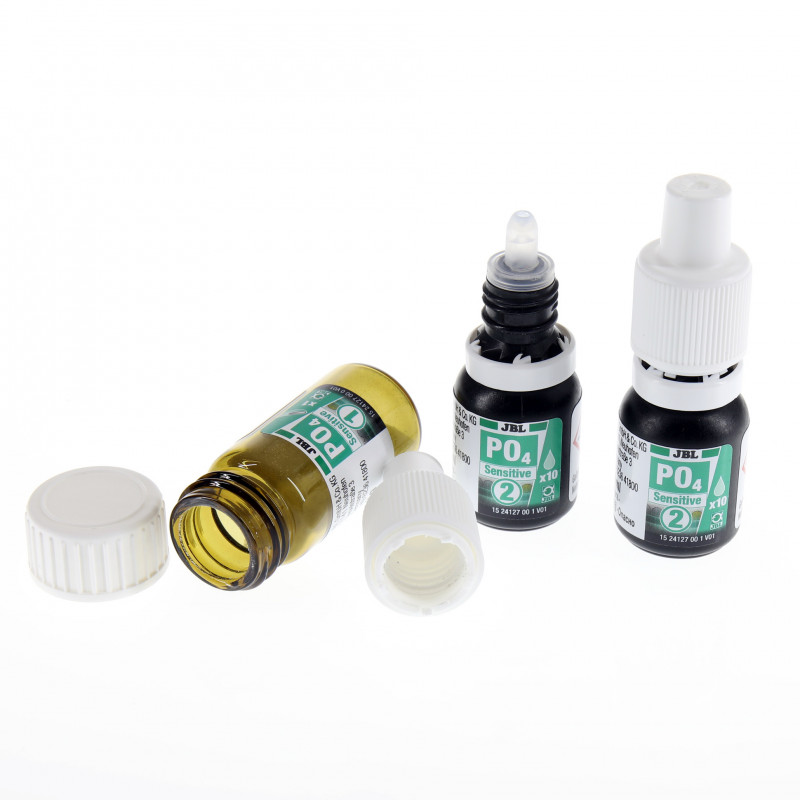More info
Importante: Incluí só a recarga!
The JBL PROAQUATEST PO4 Phosphat Sensitive is a product that allows for measuring phosphate levels in aquariums. It is important to monitor these levels because high concentrations of phosphate can cause excessive algae growth, which can harm the health of fish and aquatic plants.
- Determines the phosphate value for perfect plant growth or possible cause of algae growth in freshwater/marine water & ponds
- Laboratory comparator system to compensate the inherent water colour: fill glass vials with sample water, add reagents to a vial, place vials in holder, read values off colour chart
- Use: when setting up a new freshwater or marine aquarium: once a week. With algae problems and for checking tap water
- You will find detailed information and troubleshooting tips about water analysis on the JBL website in Essentials/Aquarium or Pond
Features: JBL PRO AQUATEST PO4 Sensitive is an easy-to-use colorimetric test for the routine monitoring of the phosphate content in fresh and marine water, and in garden pond water. A compensation method developed by JBL allows reliable results to be obtained even in slightly discoloured water (caused by peat filtering or disease treatment etc.). The high sensitivity of this test makes it possible to detect an increasing phosphate content at an early stage and to take suitable action in good time. Why test? Phosphate is an important plant nutrient. In unpolluted natural waters, the phosphate concentration is about 0.01 mg/l and about 0.07 mg/l in marine de en water. Plants and algae have adapted to this mearge phosphate supply and can survive with minimum amounts. Phosphate primarily enters the water as a result of the digestive processes of the fish and food remains. High fish stocks can lead to a phosphate content up to 100 times over the natural value. Some waterworks also add phosphates to the tap water to prevent lime deposits and corrosion in the pipe system. In the case of garden ponds, phosphate entering with pollen in spring or from garden fertilisers used near the pond also has to be taken into account. As a result of this unnaturally high nutrient supply, algae multiply almost explosively. They also can store phosphate in considerable quantities and thus continue to grow steadily for some time even after the phosphate content has been reduced. The sooner the increasing phosphate content is identified, the better the chances of averting a plague of algae. In heavily planted aquariums with only a few small fish, however, the opposite may occur: Phosphate becomes a deficiency factor and needs dosed additions for plants to thrive and grow. This is especially the case with so-called aquascaping. In freshwater aquariums the phosphate content needs to be kept below 0.4 mg/l and in marine water aquariums below 0.1 mg/l. Values below 0.1 mg/l ought to be maintained in garden ponds. Procedure: 1. Rinse two test vials several times with the water to be tested. 2. Use the enclosed syringe to fill each of the test vials with 10 ml of sample water. 3. Place a small measuring spoon (narrow end of the enclosed double-ended spoon) of reagent 1 in one of the two test vials, close with the lid and shake until the solid is completely dissolved. Add 10 drops of reagent 2. Mix by swirling and allow to stand for 10 minutes, until the full colouring develops. 4. Place both test vials in the grey comparator block: Place the vial with added reagent at the smooth end and the vial with untreated sample water (blank sample) at the notched end of the comparator block. 5. Place the comparator block with the two test vials on the colour chart in such a way that the notch points to the values and move it on the colour chart until the colour of the sample mixed with reagents corresponds as closely as possible to the colour under the blank sample. 6. Read the phosphate content in the notch of the comparator.
Note: Always point the dropper vertically downwards when using the drop bottle and avoid bubbles. The exterior surface of the dropper should be dry. Storage of reagents: Keep dry at room temperature and in original packaging.
Importante: Incluí só a recarga!




